User:Cease/Corruption: Difference between revisions
No edit summary |
No edit summary |
||
| Line 1: | Line 1: | ||
'''Corruption''' is a [[Shadow Alignment|Shadow]] strategy of corrupting the [[Ring-bearer]], usually by adding [[burden]]s until the Ring-bearer's [[resistance]] drops to 0. Several [[culture]]s can add burdens, but only a few are regularly used in corruption strategies: {{C|Ringwraith}}, {{C|Raider}} (specifically [[Easterling]]s), {{C|Moria}} (using {{Card|Lost to the Goblins}}), {{C|Sauron}} and {{C|Orc}}. | '''Corruption''' is a [[Shadow Alignment|Shadow]] strategy of corrupting the [[Ring-bearer]], usually by adding [[burden]]s until the Ring-bearer's [[resistance]] drops to 0. Several [[culture]]s can add burdens, but only a few are regularly used in corruption strategies: {{C|Ringwraith}}, {{C|Raider}} (specifically [[Easterling]]s), {{C|Moria}} (using {{Card|Lost to the Goblins}}), {{C|Sauron}} and {{C|Orc}}. | ||
Outside of the | Almost every burden-placing Shadow card comes with a choice: "Place a burden or do [x]." Outside of the rare [[bomb]] combo deck, corruption decks generally confront the [[Free Peoples]] player with a choice, to either accept the burden or accept the other cost, despite the fact that the other cost may result in other setbacks. Because [[the One Ring]] can always be used to convert [[wound]]s to burdens, undirected wounding (such as [[Archery]] or the wounds caused by [[threat]]s after you kill a [[character]]) can also be thought of as a burden effect: your opponent has to either eat the wounds as burdens, or eat them as actual wounds. If you want to be successful with a corruption deck, don't think strictly in terms of how many burdens you can stack, but rather how you can use burdens to create pressure. Each [[burden]]-placing Shadow culture creates pressure in different ways. | ||
While corruption or forcing your opponent to make bad choices are the main benefits of burdens, they're not the only benefit. A number of Shadow cards spot burdens to generate some benefit or spot/affect [[companion]]s with resistance under a certain threshold. Many of these cards are very strong in their own right: {{Card|Ulaire Enquea, Lieutenant of Morgul}} ("Shotgun Enquea") can shoot an opposing [[companion]] right off the table if you can spot enough burdens, possible triggering a cascade of [[threat]] wounds. {{Card|Neekerbreekers' Bog}} exerts every [[companion]] with resistance 4 or less, so two or three burdens are enough to force most characters to have to exert. Several cultures specialize in spotting burdens, like {{C|Wraith}}, and [[Easterling]] {{C|Raider}}s, and all of three new post-[[Shadows]] Shadow cultures ({{C|Men}}, {{C|Orc}}s, and {{C|Uruk-hai}}) have cards that especially affect low-resistance characters. | |||
== Sauron culture == | |||
{{C|Sauron}} culture had the first viable corruption strategy. It remains one of the best corruption cultures in [[Fellowship Block]], and corruption strategies remain relevant Using cards like {{Card|Desperate Defense of the Ring}} and {{Card|Thin and Stretched}}, {{C|Sauron}} adds burdens slowly to wear down a [[Ring-bearer]]'s resistance. A variant of the typical corruption would be playing {{Card|Mordor Guard}}, {{Card|Mordor Veteran}}, and {{Card|Orc Officer}} to add burdens rapidly by overwhelming a few companions. | |||
{{C|Ringwraith}} culture usually corrupts using cards like {{Card|Ulaire Enquea, Thrall of the One}}, {{Card|It Wants to be Found}}, and in [[Expanded (Format)|Expanded]] {{Card|Keening Wail}}. They also may incorporate {{Card|Gates of the Dead City}} to exhaust your [[fellowship]], potentially simply killing your [[Ring-bearer]] rather than corrupting him. Such a strategy can be even more lethal with {{Card|Drawn to its power}}. | {{C|Ringwraith}} culture usually corrupts using cards like {{Card|Ulaire Enquea, Thrall of the One}}, {{Card|It Wants to be Found}}, and in [[Expanded (Format)|Expanded]] {{Card|Keening Wail}}. They also may incorporate {{Card|Gates of the Dead City}} to exhaust your [[fellowship]], potentially simply killing your [[Ring-bearer]] rather than corrupting him. Such a strategy can be even more lethal with {{Card|Drawn to its power}}. | ||
| Line 9: | Line 16: | ||
{{C|Moria}} corruption is the rarest of these, with only the occasional {{Card|Lost to the Goblins}} [[bomb]] deck. This archetype is rare, but piling up 12 burdens in one [[Shadow Phase]] can be quite an unpleasant shock for your opponent! | {{C|Moria}} corruption is the rarest of these, with only the occasional {{Card|Lost to the Goblins}} [[bomb]] deck. This archetype is rare, but piling up 12 burdens in one [[Shadow Phase]] can be quite an unpleasant shock for your opponent! | ||
{{C|Orc}} corruption is potentially the strangest corruption strategy, recyling {{Card|Isengard Underling}} with {{Card| Goblin Hordes}}, which recurs {{Card|Bound to its fate}}, and also playing {{Card|Orc Miscreant}} with {{Card|Relentless Warg}} for extra burdening power. | {{C|Orc}} corruption is potentially the strangest corruption strategy, recyling {{Card|Isengard Underling}} with {{Card| Goblin Hordes}}, which recurs {{Card|Bound to its fate}}, and also playing {{Card|Orc Miscreant}} with {{Card|Relentless Warg}} for extra burdening power. | ||
As strong as these strategies seem, there are cards that completely shut them down. The most notorious example, only valid in pre-[[Shadows]] formats, is {{Card|Sam, Son of Hamfast}}, with his ability to remove up to 3 burdens at once, then die to the largest minion. Another, less egregious, example would be {{Card|Shadowfax, Greatest of the Mearas}} combo'ed with {{Card|Citadel to Gate}}. This card is vulnerable to {{Card|Ulaire Cantea, Faster Than Winds}} or {{Card|Too Great and Terrible}}, making [[Nazgûl]] the most effective strategy against it. | As strong as these strategies seem, there are cards that completely shut them down. The most notorious example, only valid in pre-[[Shadows]] formats, is {{Card|Sam, Son of Hamfast}}, with his ability to remove up to 3 burdens at once, then die to the largest minion. Another, less egregious, example would be {{Card|Shadowfax, Greatest of the Mearas}} combo'ed with {{Card|Citadel to Gate}}. This card is vulnerable to {{Card|Ulaire Cantea, Faster Than Winds}} or {{Card|Too Great and Terrible}}, making [[Nazgûl]] the most effective strategy against it. | ||
---- | ---- | ||
{{Gameplay_Table}} | {{Gameplay_Table}} | ||
Revision as of 05:11, 3 January 2022
Corruption is a Shadow strategy of corrupting the Ring-bearer, usually by adding burdens until the Ring-bearer's resistance drops to 0. Several cultures can add burdens, but only a few are regularly used in corruption strategies: Ringwraith,
Raider (specifically Easterlings),
Moria (using Lost to the Goblins (1R189)
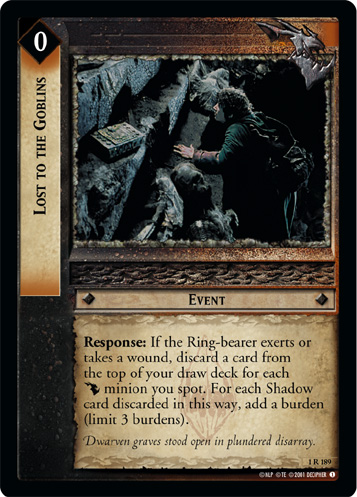 ),
), Sauron and
Orc.
Almost every burden-placing Shadow card comes with a choice: "Place a burden or do [x]." Outside of the rare bomb combo deck, corruption decks generally confront the Free Peoples player with a choice, to either accept the burden or accept the other cost, despite the fact that the other cost may result in other setbacks. Because the One Ring can always be used to convert wounds to burdens, undirected wounding (such as Archery or the wounds caused by threats after you kill a character) can also be thought of as a burden effect: your opponent has to either eat the wounds as burdens, or eat them as actual wounds. If you want to be successful with a corruption deck, don't think strictly in terms of how many burdens you can stack, but rather how you can use burdens to create pressure. Each burden-placing Shadow culture creates pressure in different ways.
While corruption or forcing your opponent to make bad choices are the main benefits of burdens, they're not the only benefit. A number of Shadow cards spot burdens to generate some benefit or spot/affect companions with resistance under a certain threshold. Many of these cards are very strong in their own right: Úlairë Enquëa, Lieutenant of Morgul (1U231)
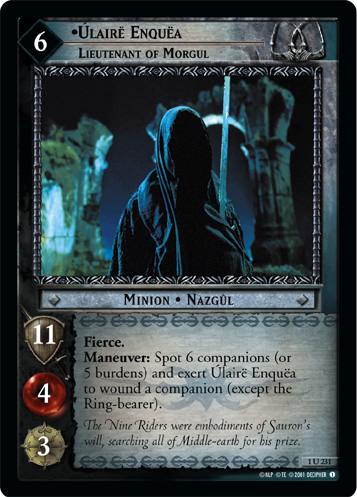 ("Shotgun Enquea") can shoot an opposing companion right off the table if you can spot enough burdens, possible triggering a cascade of threat wounds. Neekerbreekers’ Bog (11S249)
("Shotgun Enquea") can shoot an opposing companion right off the table if you can spot enough burdens, possible triggering a cascade of threat wounds. Neekerbreekers’ Bog (11S249)
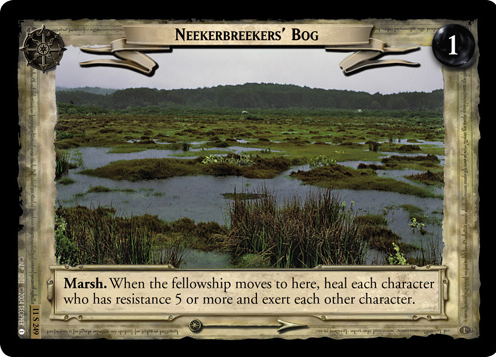 exerts every companion with resistance 4 or less, so two or three burdens are enough to force most characters to have to exert. Several cultures specialize in spotting burdens, like
exerts every companion with resistance 4 or less, so two or three burdens are enough to force most characters to have to exert. Several cultures specialize in spotting burdens, like Wraith, and Easterling
Raiders, and all of three new post-Shadows Shadow cultures (
Men,
Orcs, and
Uruk-hai) have cards that especially affect low-resistance characters.
Sauron culture
Sauron culture had the first viable corruption strategy. It remains one of the best corruption cultures in Fellowship Block, and corruption strategies remain relevant Using cards like Desperate Defense of the Ring (1R244)
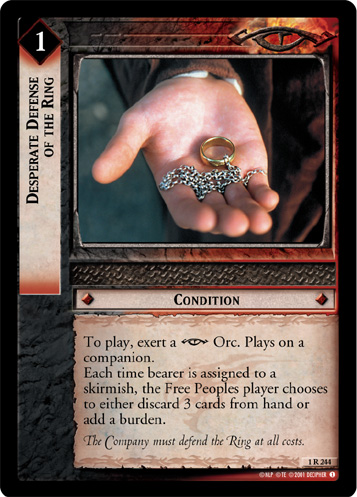 and Thin and Stretched (1R279)
and Thin and Stretched (1R279)
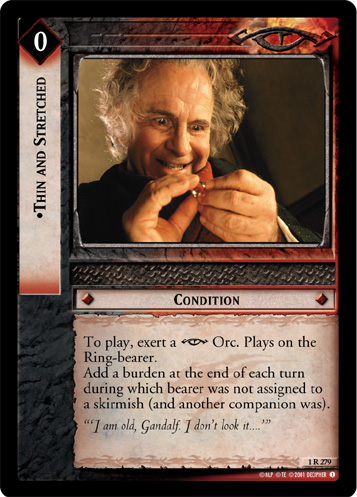 ,
, Sauron adds burdens slowly to wear down a Ring-bearer's resistance. A variant of the typical corruption would be playing Mordor Guard (7C287)
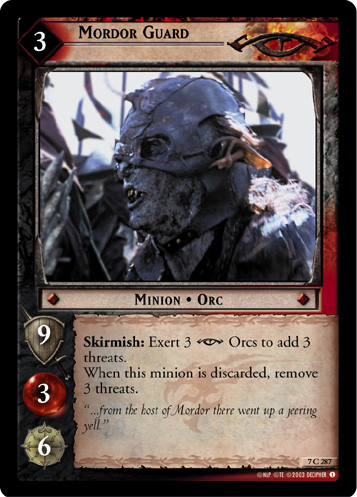 , Mordor Veteran (7U292)
, Mordor Veteran (7U292)
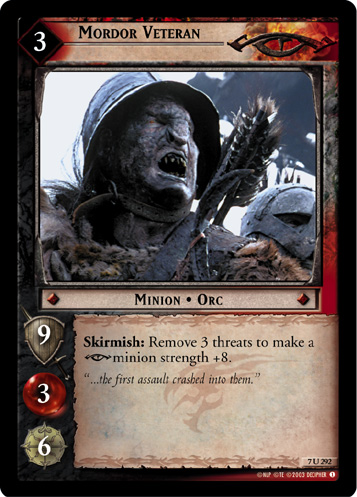 , and Orc Officer (7U302)
, and Orc Officer (7U302)
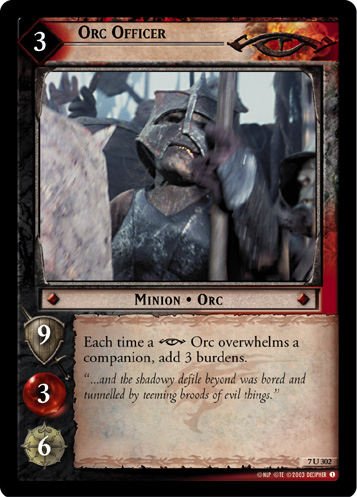 to add burdens rapidly by overwhelming a few companions.
to add burdens rapidly by overwhelming a few companions.
Ringwraith culture usually corrupts using cards like Úlairë Enquëa, Thrall of the One (10R68)
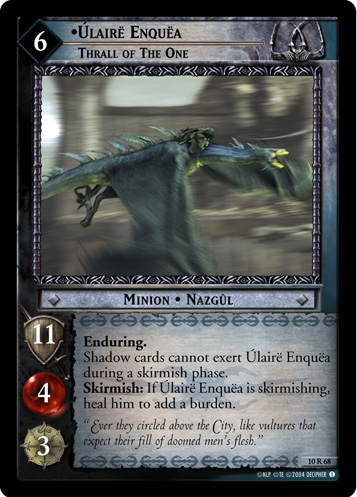 , It Wants to be Found (2U78)
, It Wants to be Found (2U78)
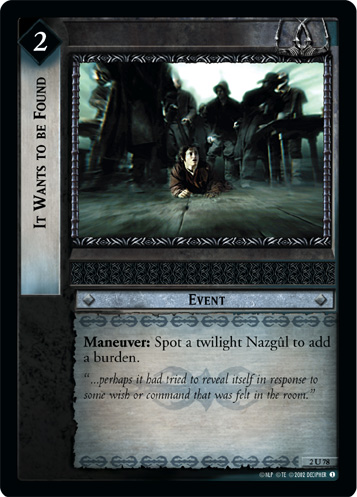 , and in Expanded Keening Wail (11R211)
, and in Expanded Keening Wail (11R211)
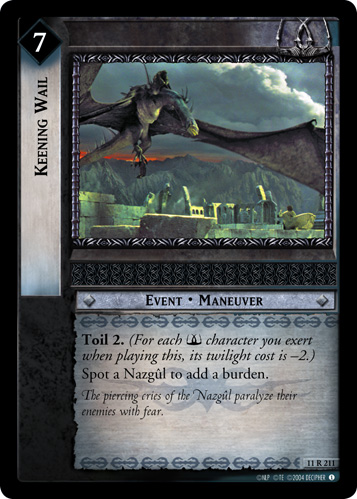 . They also may incorporate Gates of the Dead City (3R81)
. They also may incorporate Gates of the Dead City (3R81)
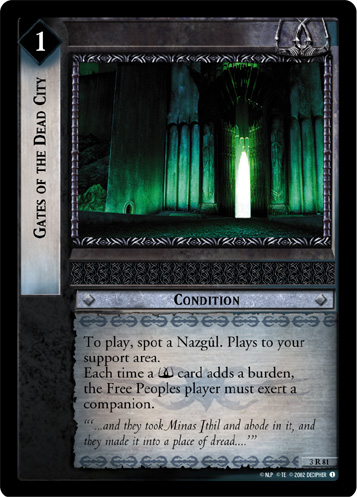 to exhaust your fellowship, potentially simply killing your Ring-bearer rather than corrupting him. Such a strategy can be even more lethal with Drawn to Its Power (1U211)
to exhaust your fellowship, potentially simply killing your Ring-bearer rather than corrupting him. Such a strategy can be even more lethal with Drawn to Its Power (1U211)
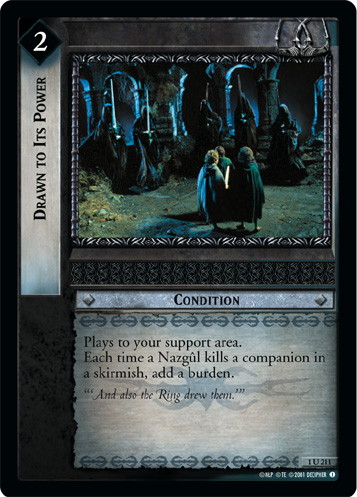 .
.
Easterling corruption often instead goes for a beatdown strategy with Small Hope (7R159)
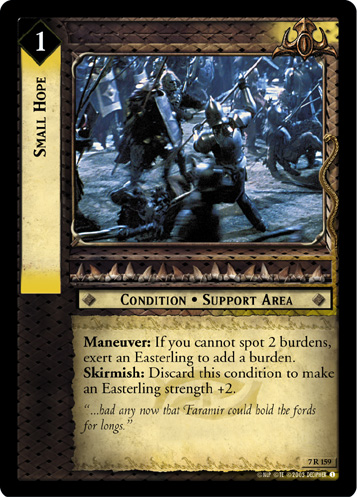 , Easterling Captain (4R225)
, Easterling Captain (4R225)
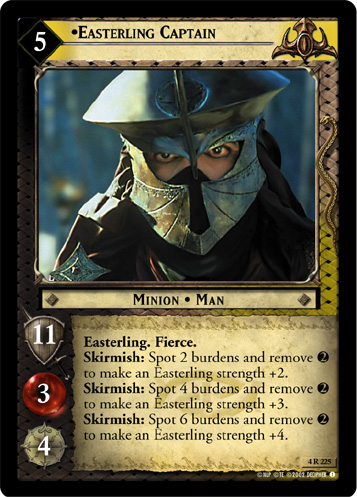 , Easterling Polearm (6U79)
, Easterling Polearm (6U79)
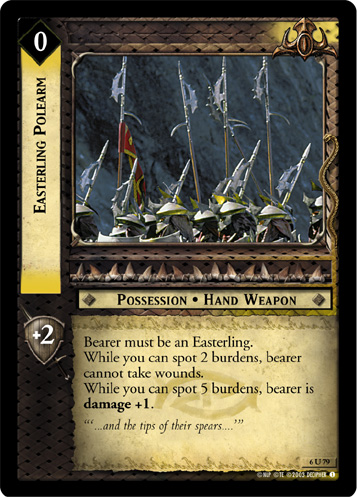 , and Raider Bow (7C155)
, and Raider Bow (7C155)
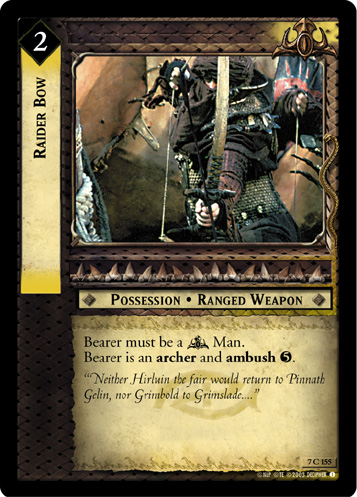 . However, with cards like Easterling Lieutenant (4C228)
. However, with cards like Easterling Lieutenant (4C228)
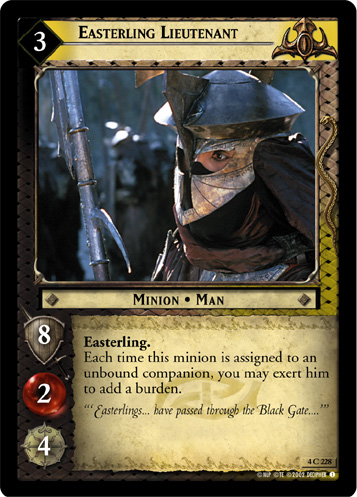 , Easterling Guard (4C226)
, Easterling Guard (4C226)
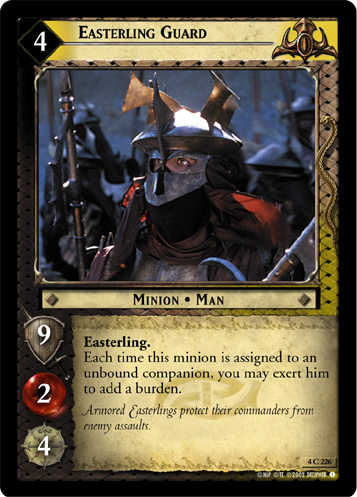 , and Vision From Afar (4R259)
, and Vision From Afar (4R259)
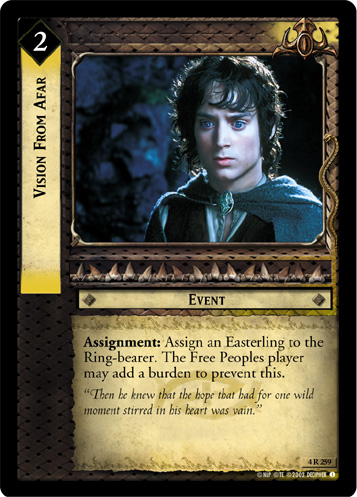 , corrupting the Ring-bearer is also possible.
, corrupting the Ring-bearer is also possible.
Moria corruption is the rarest of these, with only the occasional Lost to the Goblins (1R189)
 bomb deck. This archetype is rare, but piling up 12 burdens in one Shadow Phase can be quite an unpleasant shock for your opponent!
bomb deck. This archetype is rare, but piling up 12 burdens in one Shadow Phase can be quite an unpleasant shock for your opponent!
Orc corruption is potentially the strangest corruption strategy, recyling Isengard Underling (11C125)
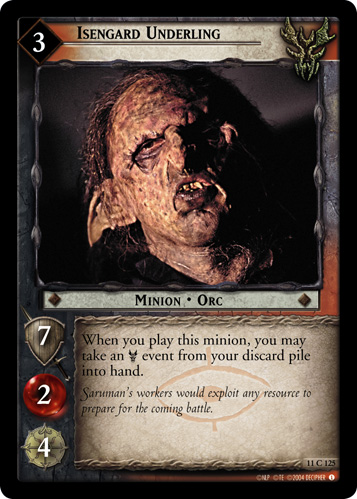 with Goblin Hordes (11R123)
with Goblin Hordes (11R123)
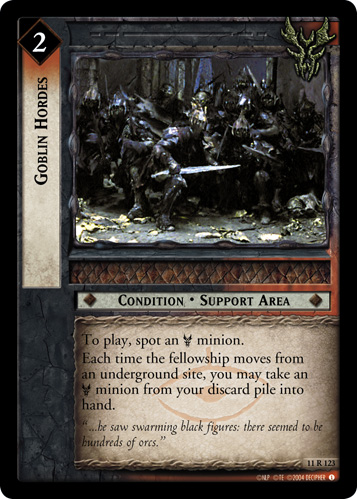 , which recurs Bound to its Fate (11U110)
, which recurs Bound to its Fate (11U110)
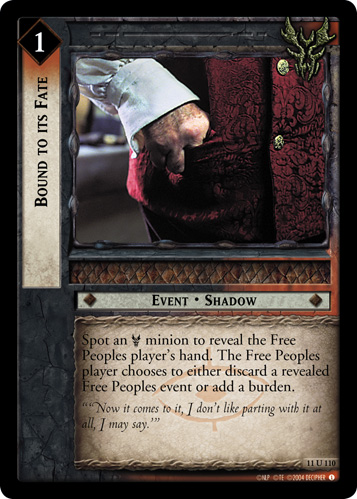 , and also playing Orc Miscreant (11C131)
, and also playing Orc Miscreant (11C131)
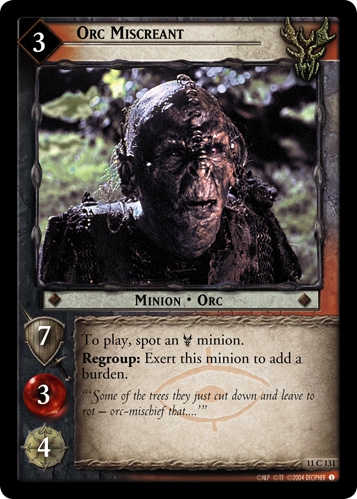 with Relentless Warg (17R89)
with Relentless Warg (17R89)
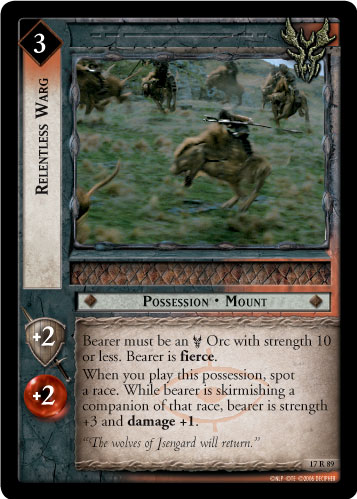 for extra burdening power.
for extra burdening power.
As strong as these strategies seem, there are cards that completely shut them down. The most notorious example, only valid in pre-Shadows formats, is Sam, Son of Hamfast (1C311)
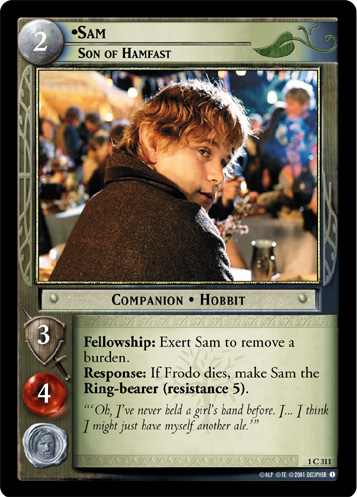 , with his ability to remove up to 3 burdens at once, then die to the largest minion. Another, less egregious, example would be Shadowfax, Greatest of the Mearas (17R24)
, with his ability to remove up to 3 burdens at once, then die to the largest minion. Another, less egregious, example would be Shadowfax, Greatest of the Mearas (17R24)
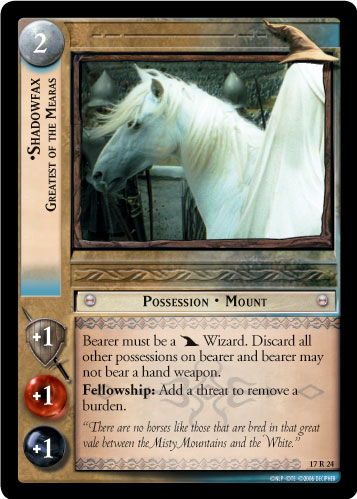 combo'ed with Citadel to Gate (7R33)
combo'ed with Citadel to Gate (7R33)
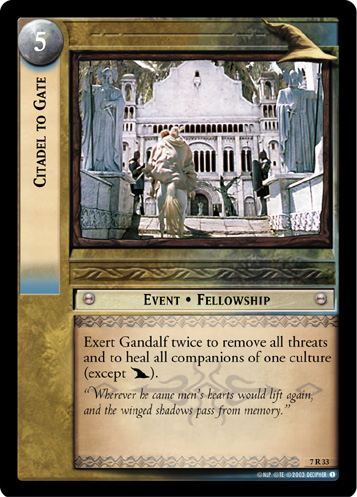 . This card is vulnerable to Úlairë Cantëa, Faster Than Winds (7R211)
. This card is vulnerable to Úlairë Cantëa, Faster Than Winds (7R211)
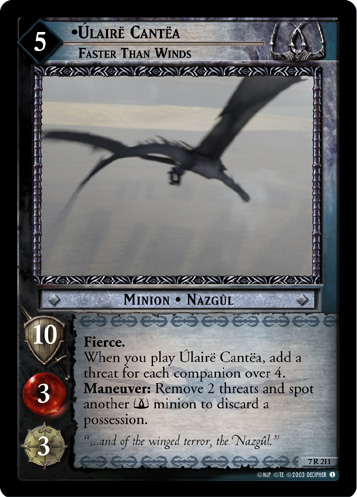 or Too Great and Terrible (3R85)
or Too Great and Terrible (3R85)
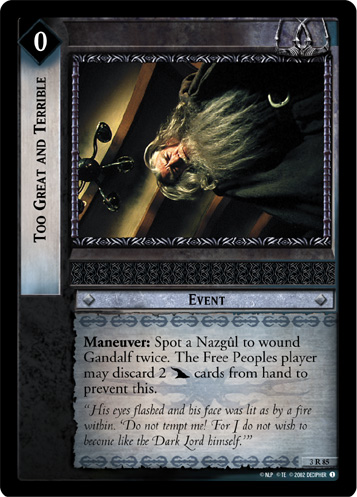 , making Nazgûl the most effective strategy against it.
, making Nazgûl the most effective strategy against it.